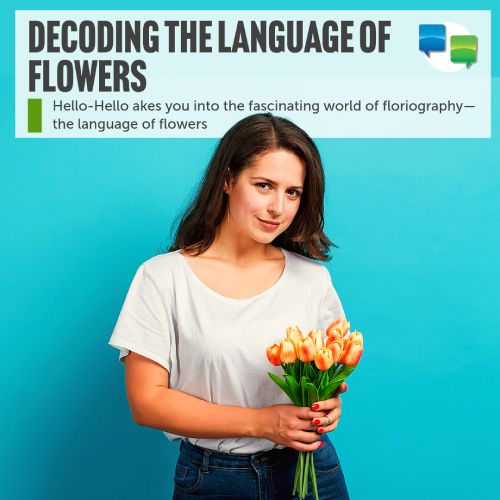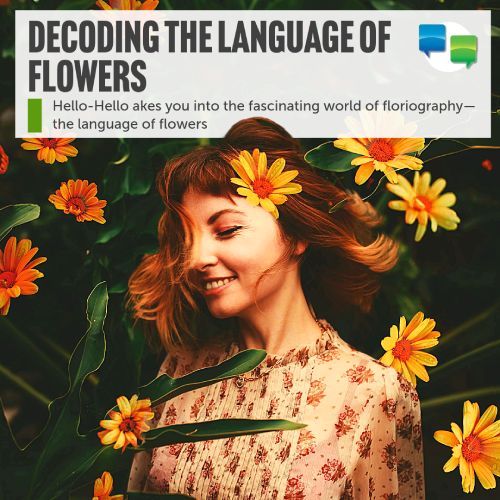Flowers have been a universal language of expression across various cultures and civilizations. Each bloom carries a unique symbolism that transcends linguistic barriers, allowing people to convey emotions and sentiments without uttering a single word. Hello-Hello the leading language learning app for iOS and Android devices takes you into the fascinating world of floriography—the language of flowers—and explores its significance in different cultures, including Spanish, French, Italian, German, Dutch, Russian, Chinese, English, Japanese, and Portuguese.
The Roots of Floriography The tradition of attributing meanings to flowers dates back to ancient times. It has been recognized for centuries in many countries throughout Europe and Asia, playing a significant role in the works of William Shakespeare and in the mythologies and folklore of ancient Greeks, Romans, Egyptians, and Chinese.
Victorian Era: The Codification of Flower Meanings During the 1800s, the language of flowers became a popular pastime. Victorian-era etiquette used flowers to deliver messages that couldn’t be spoken aloud. The way flowers were presented and their condition conveyed specific sentiments. Some Flower Symbolism Across Cultures:
Spanish and Portuguese Traditions
Madonna Lily (Lilium candidum): Also called “St. Anthony’s lily,” Madonna lily is one of the first plants that people grew for decoration 3,000 years ago. It grows in the Mediterranean area and has big, white trumpet-shaped flowers with yellow centers. It can grow as tall as a grown-up person and likes lots of sunshine and well-drained soil. Madonna lily is the official flower of Italy and is regarded as a symbol of purity by the Roman Catholic Church.
Italian Jasmine (Jasminum humile): Brought to Italy from south Iran, Italian jasmine is a bush with thin stems and dark green leaves. Wildly cultivated in Sicily, these flowers can grow up to 7 feet.
French Elegance
Roses: In Italy, red roses symbolize passion and love, white roses represent pureness, and yellow roses signify jealousy. Blue roses, with their more masculine hue, have also become popular. Roses are frequently given during romantic dinners and special occasions.
German Blossoms
Chrysanthemums: Although chrysanthemums symbolize joy and prosperity in most parts of the world, in Italy, they are associated with sadness and sorrow. Crisantemi are linked to All Souls Day (November 2) and are often brought to loved ones’ graves.
Dutch Floriography
Orchids: White orchids symbolize purity and are often chosen for wedding decorations. Rose orchids represent love and affection and are given for the 14th wedding anniversary, while cream orchids are associated with the 28th anniversary.
Russian Floral Codes
Sunflowers (Girasoli): Tuscany is famous for growing sunflowers, which symbolize happiness and cheerfulness. They are often given to celebrate achievements and successful events.
Chinese Floral Language
Peony: Known as the “king of flowers,” the peony symbolizes prosperity and honor in Chinese culture. Cherry blossoms (sakura) represent the transient nature of life, echoing themes of renewal and hope.
Japanese Hanakotoba
- Sakura (Cherry Blossom): Represents beauty, transience, and renewal.
- Ume (Plum Blossom): Symbolizes endurance and perseverance.
- Kiku (Chrysanthemum): Signifies longevity and nobility.
- Tsubaki (Camellia): Conveys deep love and affection.
- Hana (Flower): Represents general beauty and elegance.
Modern-Day Floriography Today, the language of flowers remains a charming and nuanced way to express feelings. While the meanings may vary across cultures, the essence of floriography is shared worldwide—a silent, beautiful expression of our deepest emotions.
The language of flowers is a testament to the shared human experience. It bridges gaps between languages and cultures, allowing us to communicate in a way that words sometimes cannot. Whether it’s a single bloom or a lavish bouquet, flowers can speak volumes, telling stories of love, loss, celebration, and hope. This exploration into the language of flowers reveals a rich tapestry of cultural significance.
Learn Spanish (Hello-Hello) – Check out the new version of our Spanish language learning app for iPhone and iPad. Learn Spanish with Hello-Hello offers a completely new and improved version of our app with animated videos, a redesigned interface and additional features! Follow our adorable characters on a fun journey to learn Spanish! Seriously, this is now, by far, THE BEST language learning app available on iTunes 🙂 Animated videos and comic strips. New games to practice reading and listening skills. Cleaner and more friendly user interface. Follow your course progress Take notes Receive notifications with lesson reminders. The more you practice, the more you learn! Receive notifications with new words to build your vocabulary
Check out the iTunes store Hello-Hello Spanish app here



